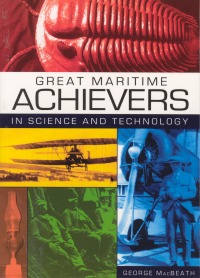| ________________
CM . . .
. Volume XI Number 14 . . . . March 18, 2005
excerpt:
On page seventy-four of Great Maritime Achievers, there is a photograph of Loring Woart Bailey conducting a chemistry experiment. Dressed in top hat and tails and absorbed in his work, the Victorian scientist looks more like a magician or snake oil salesman than a dusty academic. Sadly, his biography reveals that he was, in fact, a dusty academic. Fields of study and publications are carefully listed so as to differentiate him within the parade of dusty academics that precede and follow him in this slim volume. But what really differentiates him is that photo: rakishly handsome as he bends over the unlabeled bottles and jumbled mess of his "lab," Bailey is spared the stiff, formal portrait that is the more typical illustration found here. Bailey's photo invites the kind of questions that are not answered by the dignified, humourless biographies in this book. Could a chemistry lab really consist of two narrow shelves nailed to a peeling wall? Did the dashing Bailey find fans among the ladies of New Brunswick? What did this Harvard-educated man-of-the-world make of life in Fredericton circa 1900? Great Maritime Achievers in Science and Technology is an expanded catalogue from an exhibition that is currently running at Science East in Fredericton. The book features brief (one to five page) biographies of twenty-nine individuals and one research team. The table of contents rounds up the usual suspects: dead white men such as Alexander Graham Bell, Abraham Gesner and George Mercer Dawson. A more careful examination reveals that there are four dead white women in the list: Bell's wife, who financed the great man's work; the first woman in the British Empire to earn a degree in undergraduate sciences; and a pair of battlefield nurses. The inclusion of these women only underscores the oddly retrograde nature of Great Maritime Achievers. This collection of eminent Victorians could sit quite comfortably among any number of books published before the social history revolution of the 1970s. The achievements described herein too often consist of degrees earned, publications esteemed within specialist circles, membership in the Royal Society of Canada and other conventional measures of respect and accomplishment. A smattering of self-taught inventors appear, but where are the crackpots, kooks and eccentrics? Where is the celebration of homespun smarts that acknowledges the vernacular contributions made by unnamed innovators and backyard tinkerers? The place for this book is in the adult collection, not in a children's or young adult collection. The individual biographies are well-written, and it is an undoubtedly worthy project to commemorate the lives and work of the professors and natural philosophers of yore. But this book simply is not suited to the needs of young adult readers. The language is as dry, refined and high falutin' as the men it describes, and the individual biographies offer neither sufficient detail to fuel a high-school project nor any specific suggestions for further reading. That said, there is a wonderful children's or young adult book waiting to be born from the Great Maritime Achievers project. Select four or five of the more interesting subjects, include additional information about their childhood and youth, and add colour illustrations and more engaging black-and-white photos. Follow each biography with a bibliography to spur further reading. Frame the biographies with an introduction that explains why the accomplishments of women, aboriginals and blacks are largely undocumented or even better, describe, for a start, the knowledge that aboriginal peoples shared with Europeans; celebrate the creative solutions to practical problems found by uneducated women and men; and recognize the tenacious independence and canny problem-solving that allowed Black Loyalists, somehow, to eke out an existence on the substandard farmland that they were given upon their arrival in the Maritimes. Now that would be a book to recommend to young adult readers! Not Recommended. Greg Bak is an information specialist with the Canadian Coordinating Office for Health Technology Assessment in Ottawa, ON.
To comment
on this title or this review, send mail to cm@umanitoba.ca.
Copyright © the Manitoba Library Association. Reproduction for personal
use is permitted only if this copyright notice is maintained. Any
other reproduction is prohibited without permission.
NEXT REVIEW |TABLE OF CONTENTS FOR THIS ISSUE
- March 18, 2005.
AUTHORS
| TITLES | MEDIA REVIEWS
| PROFILES
| BACK ISSUES
| SEARCH | CMARCHIVE
| HOME |
